Every week, one or more of my students will discover intricate mazes and pathways chewed through dead pine branches on the forest floor. I use this discovery to teach my students how just one seemingly small factor can tip the scale and generate massive change.
These tiny lines on logs are evidence of a great change underway in our western pine forests: the rise of the Pine Bark Beetles.
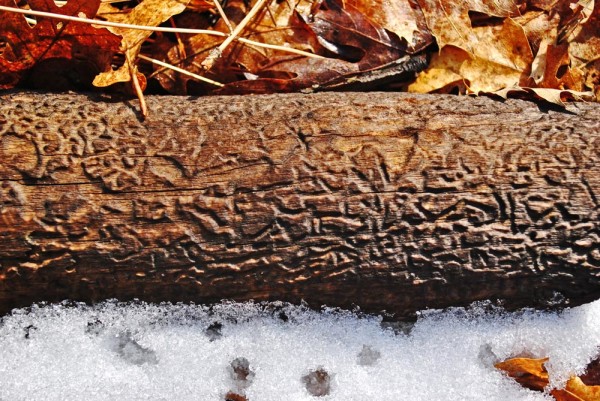
Those squiggly lines are made by beetles
There are about 6,000 known species of bark beetle. 1 These rice-grain sized insects lay their eggs in the inner bark of trees, enabling larvae to chew through the sugary, nutrient-rich outer wood, known as phloem. There are 19 species of pine beetle native to California, which have coexisted peacefully with our mountain forests for thousands of years.2
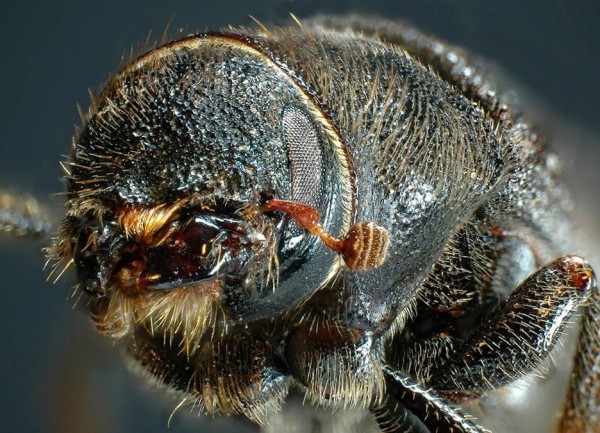
I am Pine Beetle. Hear me Roar!
Yet in the last few decades we’ve seen a shift in the power balance. The conditions of the environment have changed in such a way that even a native insect can turn into an unstoppable destructive force. Like so many other areas of the world, the scales are being tipped by human-induced climate change.
We know that the pine beetle has historically been important for the health of pine forests. When a tree becomes stressed by poor climate conditions, animal or wind damage, pollution, or possibly an infection, the beetles are likely to colonize the phloem, and eat away.

Pitch coming out of a tree at High Trails
A healthier tree can endure thousands of invaders, secreting resin, also known as amber or pine pitch, to push them out and prevent excessive damage. With the proper balance in this tree-beetle battle, the weaker trees will be weeded out, allowing the healthier ones to remain with access to more sun, water, and nutrients.
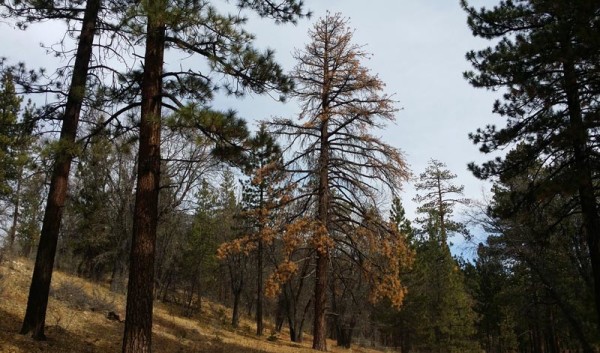
A big, beautiful, and now brown-needled ponderosa pine.
The result is a healthy ecosystem with enough trees to provide food, habitat, and nutrient-rich, stable soil for other forest creatures. But when we change the conditions, this balance is thrown away.Due to global climate change, our shorter winters allow more pine beetles to reproduce than ever before. The drought conditions put more and more trees in the “stress zone.” With these high beetle populations and weaker trees, one Ponderosa Pine could succumb to a few hundred invaders, while they might have defended thousands before.
In the US and Canada, over 60 million acres of forest have suffered die-offs due to bark beetles, most notably the Mountain Pine Beetle. 3 Huge swaths of the Rocky Mountains are turned rust brown as entire forests die away.

Beetles take over BC
In California, about 1% of our land area is affected by pine beetles, mostly in the Southern Sierra – but our San Bernardino Mountains are beginning to see effects as well. There are several species affecting our mountains in particular, all of which are native. Mountain Pine Beetle infests Ponderosas and Sugar Pines, the Western Pine Beetle attacks Coulter Pines and Ponderosas, the Fir Engraver eats away at our White Firs, and the Pine Engraver Beetle eats away at many different pine species. 4
The lost battle for the trees is evidenced by browned, dead branches throughout the tree, and pine resin leaking out from the trunk in a failed attempt to fight back the invaders.
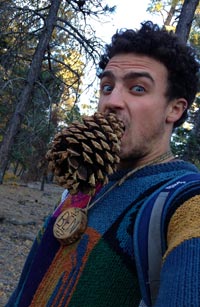
Tree Hugger. Pine Cone Eater.
Remember how a small factor can enact large change? Small bark beetles can kill large trees. This dead pine litter can make forest fires more intense, harming humans, wildlife, and also stressing more trees. The dead forests can no longer extract CO2 from our atmosphere, and as a result the greenhouse effect can run away even further.
Like the embattled trees, my coworkers and I are fighting our own incredibly important battle right here in the mountains. If our students can begin to understand how complex, but delicate, the web of an ecosystem is, then we can take steps toward environmental awareness and a passion for a healthier world.
Another good source: http://www.nps.gov/romo/learn/nature/mtn_pine_beetle_background.htm
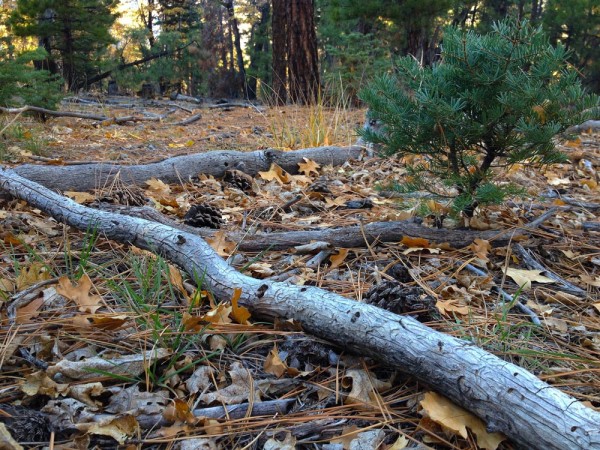
A maze on a log found by Ben’s students
At High Trails Outdoor Science School, we literally force our instructors to write about elementary outdoor education, teaching outside, learning outside, our dirty classroom (the forest…gosh), environmental science, outdoor science, and all other tree hugging student and kid loving things that keep us engaged, passionate, driven, loving our job, digging our life, and spreading the word to anyone whose attention we can hold for long enough to actually make it through reading this entire sentence. Whew…. www.dirtyclassroom.com
- http://www.fs.usda.gov/Internet/FSE_DOCUMENTS/stelprdb5384837.pdf ↩
- http://www.sfchronicle.com/science/article/Bark-beetles-ravaging-drought-stricken-forests-in-6165431.php ↩
- http://ngm.nationalgeographic.com/2015/04/pine-beetles/rosner-text ↩
- http://www.fs.usda.gov/Internet/FSE_DOCUMENTS/stelprdb5384837.pdf ↩

Comments are closed.